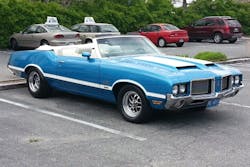John Turner has had an affinity for Oldsmobiles since he was in high school. With his friends acquiring the more popular muscle cars, Turner decided he wanted to be different.
His first Oldsmobile was a stock 1979 Cutlass Supreme, but it wasn’t long before a blown engine opened the doors to more power.
Turner found a stock 455 Oldsmobile engine from the junkyard and stuffed it into his ’79 cutlass. The added power was all the spark he needed to find a lifelong hobby of fixing up cars and making them fast.
“That was the beginning of my Oldsmobile crusade,” Turner says.
Turner, owner of JT’s Collision Repair in Eldersburg, Md., now has 5 classics that he’s rebuilt or restored with his experience as a collision paint specialist—a career he chose for the detail-oriented work and need for precision.
When he bought his ’72 442 in 2006, it was a true “50-footer,” Turner says. “It looked good from 50 feet, but needed some work.”
The 442 turned into a two-and-a-half year project that featured redone quarter panels, a nearly complete teardown and a Glasurit 90 line paint job with W-30 stripes.
“Somebody had botched the quarters when they put them on,” Turner says. “We had it sand blasted and completely down to bare metal. I’ve always had a soft spot for the Viking Blue with white stripes.”
With the car torn apart, Turner decided to freshen up a 461 Olds racing engine with Batten aluminum heads that he had laying around, a byproduct of his years of racing Oldsmobiles at the local track.
The original engine, Turner says, was a stock 455, but just wasn’t fast enough for someone who grew up around muscle cars. Now, the remade convertible puts 640 horsepower to the wheels.
To make the ’72 more convenient to drive, Turner had the compression lowered so it would be street legal and run on standard gas. Now Turner takes his Oldsmobiles to car shows where he can share them with other enthusiasts and advertise his paint jobs through word of mouth.
“Some of the late-model guys want the FS stripes or the Shelby stripes on their cars,” Turner says. “They want them painted instead of the factory decals. We’ve got a number of jobs lined up.”
Having begun working on cars in high school, Turner says he had his parents’ full support when he began tinkering on his own car and doing work for friends.
“My parents were very supportive, because if I was working on cars, I was at the house and not out doing drugs or drinking and driving,” Turner says.
Turner added that his ideal model now would be a 1968 Hurst, the first GM intermediate-sized car to offer an engine larger than 400ci.
“It was ahead of its time, and would be a neat piece to have,” Turner says. “I’m not sure I would drive it, because it’d be too valuable.”
